
NExT-GPT
Code and models for NExT-GPT: Any-to-Any Multimodal Large Language Model
Stars: 3245
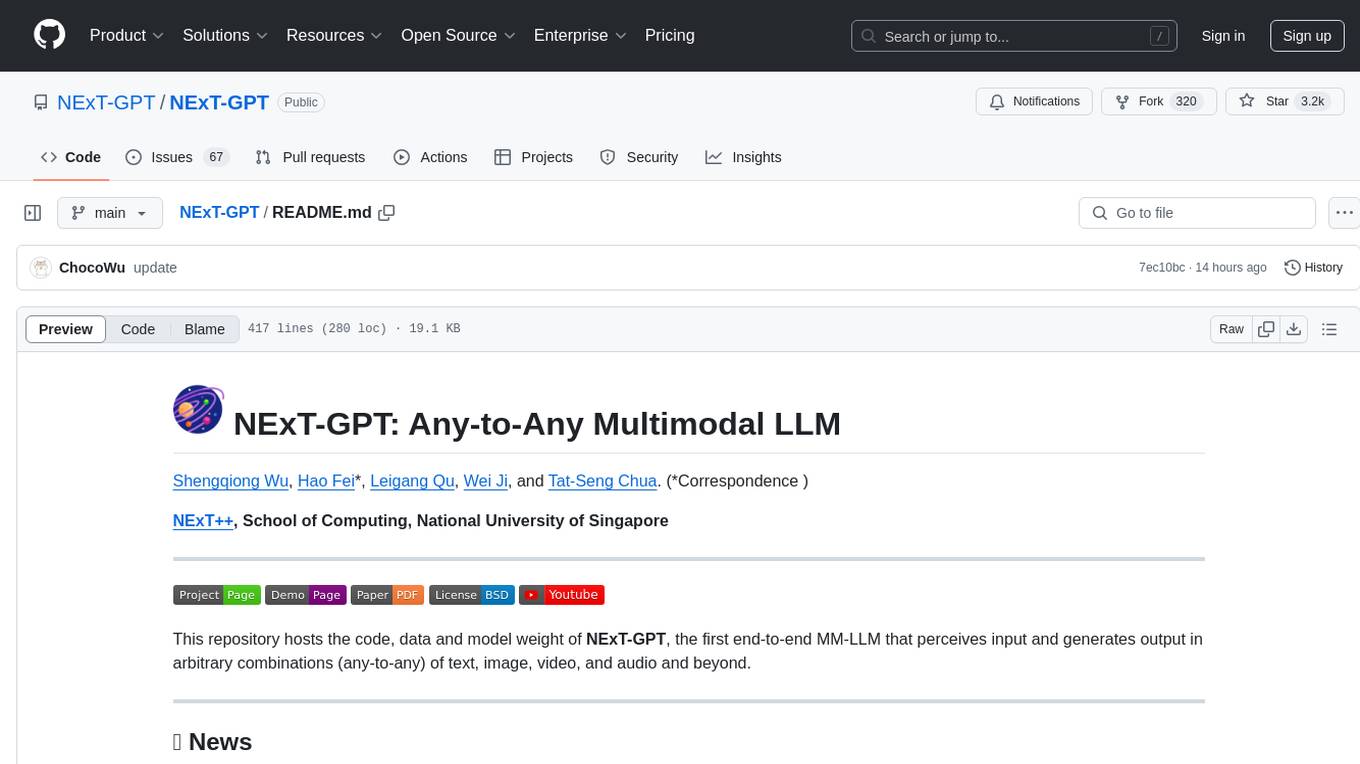
NExT-GPT is an end-to-end multimodal large language model that can process input and generate output in various combinations of text, image, video, and audio. It leverages existing pre-trained models and diffusion models with end-to-end instruction tuning. The repository contains code, data, and model weights for NExT-GPT, allowing users to work with different modalities and perform tasks like encoding, understanding, reasoning, and generating multimodal content.
README:
Shengqiong Wu, Hao Fei*, Leigang Qu, Wei Ji, and Tat-Seng Chua. (*Correspondence )
NExT++, School of Computing, National University of Singapore
This repository hosts the code, data and model weight of NExT-GPT, the first end-to-end MM-LLM that perceives input and generates output in arbitrary combinations (any-to-any) of text, image, video, and audio and beyond.
Noted: we wrap the former old codebase into the NExT-GPT-Lagacy. Please refer to this new codebase for all training and tuning procedures.
- [x] [2023.09.15] 🚀🚀 Release the code of NExT-GPT in version
7b_tiva_v0. - [x] [2023.09.27] 🔨🧩 Added modality-blended batch sampler.
- [x] [2023.10.01] 📢📢 Release the T2M instruction dataset.
- [x] [2023.10.04] 👏👏 Release the checkpoint of NExT-GPT in version 7b_tiva_v0 .
- [x] [2023.10.15] 🔨🚀 Update of NExT-GPT in version 7b_tiva_v0 .
- [x] [2024.10.07] 👏👏 Release the data and the corresponding construction methods, please refer DATA_README.md for more details.
- [ ] Updating NExT-GPT in more types&sizes of LLMs.
- [ ] Empowering NExT-GPT with more modalities of inputs&outputs.
- [ ] ...
Here we showcase examples generated from NExT-GPT. For more examples, kindly visit the webpage, or the online live demo.
https://github.com/NExT-GPT/NExT-GPT/assets/18722770/0c2b3d88-a533-4899-ab44-65580fe54538
https://github.com/NExT-GPT/NExT-GPT/assets/18722770/eb1319a6-38aa-4546-a96e-163207e7de93
https://github.com/NExT-GPT/NExT-GPT/assets/18722770/36bec0ad-9bad-4bcf-bc37-92b028f1bc6a
NExt-GPT is built on top of existing pre-trained LLM, multimodal encoder and SoTA diffusion models, with sufficient end-to-end instruction tuning.
- Multimodal Encoding Stage. Leveraging established encoders to encode inputs in various modalities, where these representations are projected into language-like representations comprehensible to the LLM through a projection layer.
- LLM Understanding and Reasoning Stage. Harnessing an existing open-sourced LLM as the core to process input information for semantic understanding and reasoning. The LLM not only directly generates text tokens but also produces unique “modality signal” tokens that serve as instructions to dictate the decoding layers whether & what modal content to output correspondingly.
- Multimodal Generation Stage. Receiving the multimodal signals with specific instructions from LLM (if any), the Transformer-based output projection layers map the signal token representations into the ones that are understandable to following multimodal decoders.
For more technical details, kindly refer to the paper.
- 1. Code Structure
- 2. Environment Preparation
- 3. Training/Adapting NExt-GPT on Your Own
- 4. Running NExT-GPT System
- 5. Fine-tuning your own System
.
|-- NExT-GPT-Lagacy # the previous version of the model
|-- assets
|-- checkpoints # save the pretraining and tuning checkpoints
|-- data
| |-- IT_data
| | |-- MosIT_data
| | |-- T+X-T_data # text+[image/audio/video] to text instruction data
| | `-- T-T+X_data # synthesized text to text+[image/audio/video] instruction data
| |-- T_X_pair_data # text-autio pairs data
| | |-- audiocap
| | |-- cc3m
| | `-- webvid
| |-- embed
| `-- prepare_data.py
|-- figures
|-- merge_lora_weights.py
|-- nextgpt
| |-- __init__.py
| |-- constants.py
| |-- conversation.py
| |-- dataset
| | |-- __init__.py
| | |-- audio_processor.py
| | |-- base_dataset.py
| | |-- catalog.py
| | |-- concat_dataset.py
| | |-- dataset_utils.py
| | `-- sampler.py
| |-- mm_utils.py
| |-- model
| | |-- __init__.py
| | |-- apply_delta.py
| | |-- builder.py
| | |-- consolidate.py
| | |-- language_model
| | |-- make_delta.py
| | |-- multimodal_decoder
| | |-- multimodal_encoder
| | |-- multimodal_projector
| | |-- nextgpt_arch.py
| | `-- utils.py
| `-- utils.py
|-- scripts
| |-- finetune.sh
| |-- pretrain_dec.sh
| |-- pretrain_enc.sh
| |-- zero2.json
| |-- zero3.json
| `-- zero3_offload.json
|-- LICENSE.md
|-- README.md
|-- nextgpt_trainer.py
|-- predict.py
|-- preprocess_embeddings.py
|-- requirements.txt
|-- train.py
|-- train_mem.py
`-- training_utils.py
2. Environment Preparation [Back to Top]
Please first clone the repo and install the required environment, which can be done by running the following commands:
conda env create -n nextgpt python=3.8
conda activate nextgpt
# CUDA 12.1
conda install pytorch==2.1.2 torchvision==0.14.1 torchaudio==0.13.1 pytorch-cuda=11.6 -c pytorch -c nvidia
git clone https://github.com/NExT-GPT/NExT-GPT.git
cd NExT-GPT
pip install -r requirements.txt
3.1. Preparing Pre-trained Checkpoint [Back to Top]
NExT-GPT is trained based on following excellent existing models. Please follow the instructions to prepare the checkpoints.
-
ImageBindis the unified image/video/audio encoder. The pre-trained checkpoint can be downloaded from here with versionhuge. Afterward, put theimagebind_huge.pthfile at [.pretrain_ckpt/imagebind]. -
Vicuna: prepare the pretrained vicuna from [here]. Then put the pre-trained model at [./pretrain_ckpt/vicuna-7b-v1.5/]. -
Image Diffusionis used to generate images. NExT-GPT uses Stable Diffusion with versionv2. (will be automatically downloaded) -
Audio Diffusionfor producing audio content. NExT-GPT employs AudioLDM with versionl-full. (will be automatically downloaded) -
Video Diffusionfor the video generation. We employ ZeroScope with versionv2_576w. (will be automatically downloaded)
3.2. Preparing Dataset [Back to Top]
Please download the following datasets used for model training:
A) T-X pairs data
-
CC3Mof text-image pairs, please follow this instruction [here]. Then put the data at [./data/T-X_pair_data/cc3m]. -
WebVidof text-video pairs, see the [instruction]. The file should be saved at [./data/T-X_pair_data/webvid]. -
AudioCapof text-audio pairs, see the [instruction]. Save the data in [./data/T-X_pair_data/audiocap].
B) Instruction data
-
T+X-T
-
LLaVAof the visual instruction data, download it from here, and then put it at [./data/IT_data/T+X-T_data/llava]. -
Alpacaof the textual instruction data, download it from here, and then put it at [./data/IT_data/T+X-T_data/alpaca/]. -
VideoChat, download the video instruction data here, and then put it at [./data/IT_data/T+X-T_data/videochat/].
Side note:After downloading dataset, please run
prepare_data.pyto preprocess the dataset. -
-
T-X+T (T2M)
- The
T-X+Tinstruction datasets (T2M) are saved at [./data/IT_data/T-T+X_data].
- The
-
MosIT
- Download the file from here, put them in [./data/IT_data/MosIT_data/]. (We are in the process of finalizing the data and handling the copyright issue.)
3.3. Precomputing Embeddings [Back to Top]
In decoding-side alignment training, we minimize the distance between the representation of signal tokens and captions. To save costs of time and memory, we precompute the text embeddings for image, audio and video captions using the text encoder within the respective diffusion models.
Please run this command before the following training of NExT-GPT, where the produced embedding file will be saved at [./data/embed].
cd ./code/
python preprocess_embeddings.py ../data/T-X_pair_data/cc3m/cc3m_generation.json image ../data/embed/ stabilityai/stable-diffusion-2
Note of arguments:
- args[1]: path of caption file;
- args[2]: modality, which can be
image,video, andaudio; - args[3]: saving path of embedding file;
- args[4]: corresponding pre-trained diffusion model name.
3.4. Training NExT-GPT [Back to Top]
First of all, please refer to the base configuration file [training_utils.py] for the basic system setting of overall modules, and dataset configuration nextgpt/dataset/catalog.py. The whole NExT-GPT training involves 3 steps:
-
Step-1: Encoding-side LLM-centric Multimodal Alignment. This stage trains the input projection layer while freezing the ImageBind, LLM, output projection layer.
# Encoding-side LLM-centric Multimodal Alignment bash scripts/pretrain_enc.sh -
Step-2: Decoding-side Instruction-following Alignment. This stage trains the output projection layers while freezing the ImageBind, LLM, input projection layers.
# Encoding-side LLM-centric Multimodal Alignment bash scripts/pretrain_enc.sh -
Step-3: Instruction Tuning. This stage instruction-tune 1) the LLM via LoRA, 2) input projection layer and 3) output projection layer on the instruction dataset.
# Encoding-side LLM-centric Multimodal Alignment bash scripts/pretrain_enc.sh
4. Running NExT-GPT System [Back to Top]
First, loading the pre-trained NExT-GPT system.
-
Step-1: load
Frozen parameters. Please refer to 3.1 Preparing Pre-trained Checkpoint. -
Step-2: load
Tunable parameters. Please put the NExT-GPT system at ./checkpoints/nextgpt-v1.5-7b. You may either 1) use the params trained yourselves, or 2) download our checkpoints from Huggingface.
Upon completion of the checkpoint loading, you can run the prediction via:
python predict.py
5. Fine-tuning Your Own System [Back to Top]
You can define your own dataset, please refer to the base_dataset.py, and then add the dataset catalog in catalog.py, including the target and parameters.
- Multimodal Encoder: You can leverage your own multimodal encoder in multimodal encoder directory, and add corresponding code in the builder.py.
- Multimodal Decoder: You can add your own multimodal decoder, in multimodal decoder directory, and modify the corresponding code in the builder.py.
- Projector: You can design your own input and output projector in multimodal projector.
You can pre-define the model, data, and training parameters in training_utils.py. Please refer the finetune.sh for fine-tuning your own model.
For any questions or feedback, feel free to contact Shengqiong Wu and Hao Fei.
If you find NextGPT useful in your research or applications, please kindly cite:
@articles{wu2023nextgpt,
title={NExT-GPT: Any-to-Any Multimodal LLM},
author={Shengqiong Wu and Hao Fei and Leigang Qu and Wei Ji and Tat-Seng Chua},
journal = {CoRR},
volume = {abs/2309.05519},
year={2023}
}
You may refer to related work that serves as foundations for our framework and code repository,
Vicuna,
ImageBind,
Stable Diffusion,
AudioLDM, and
Zeroscope.
We also partially draw inspirations from
PandaGPT,
GILL,
CoDi,
Video-LLaMA,
LLaVA,
and MiniGPT-4.
Thanks for their wonderful works.
This repository is under BSD 3-Clause License. NExT-GPT is a research project intended for non-commercial use only. One must NOT use the code of NExT-GPT for any illegal, harmful, violent, racist, or sexual purposes. One is strictly prohibited from engaging in any activity that will potentially violate these guidelines. Any potential commercial use of this code should be approved by the authors.
For Tasks:
Click tags to check more tools for each tasksFor Jobs:
Alternative AI tools for NExT-GPT
Similar Open Source Tools

NExT-GPT
NExT-GPT is an end-to-end multimodal large language model that can process input and generate output in various combinations of text, image, video, and audio. It leverages existing pre-trained models and diffusion models with end-to-end instruction tuning. The repository contains code, data, and model weights for NExT-GPT, allowing users to work with different modalities and perform tasks like encoding, understanding, reasoning, and generating multimodal content.
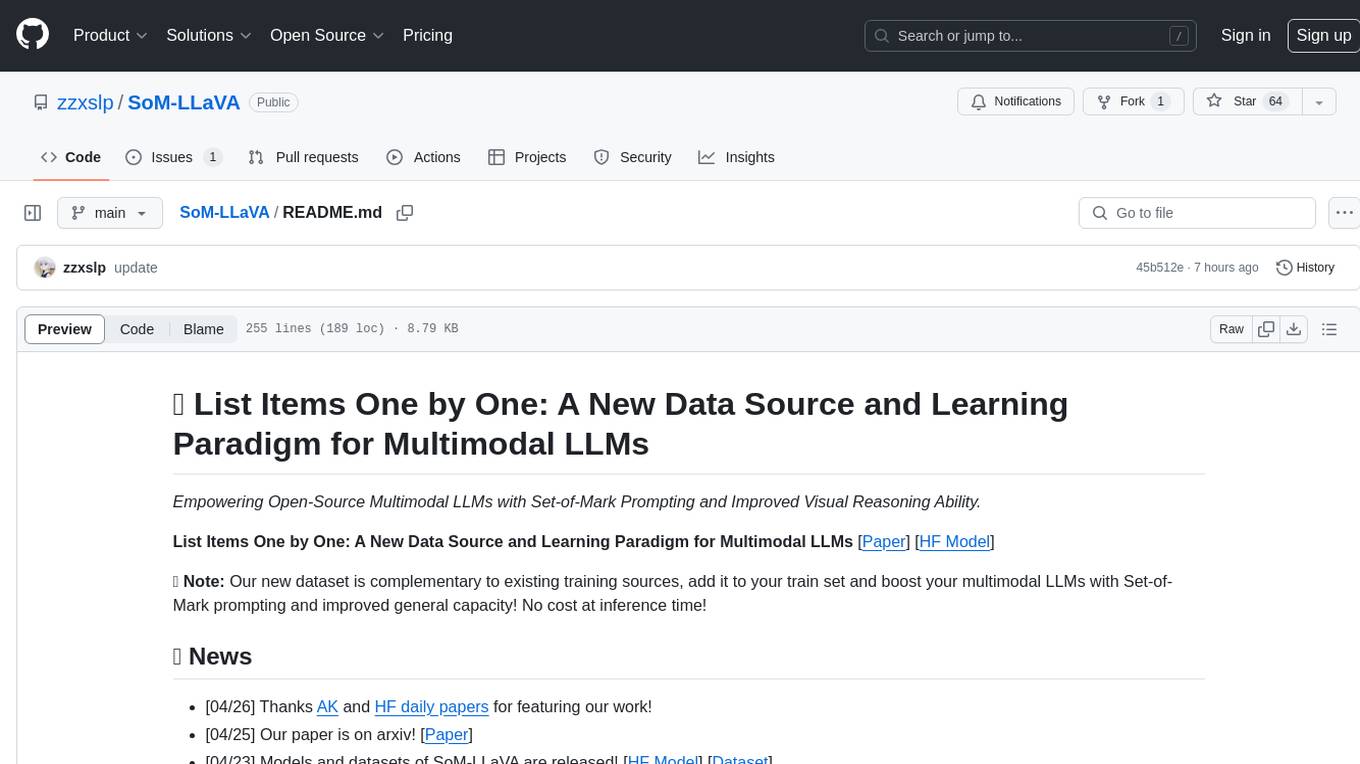
SoM-LLaVA
SoM-LLaVA is a new data source and learning paradigm for Multimodal LLMs, empowering open-source Multimodal LLMs with Set-of-Mark prompting and improved visual reasoning ability. The repository provides a new dataset that is complementary to existing training sources, enhancing multimodal LLMs with Set-of-Mark prompting and improved general capacity. By adding 30k SoM data to the visual instruction tuning stage of LLaVA, the tool achieves 1% to 6% relative improvements on all benchmarks. Users can train SoM-LLaVA via command line and utilize the implementation to annotate COCO images with SoM. Additionally, the tool can be loaded in Huggingface for further usage.
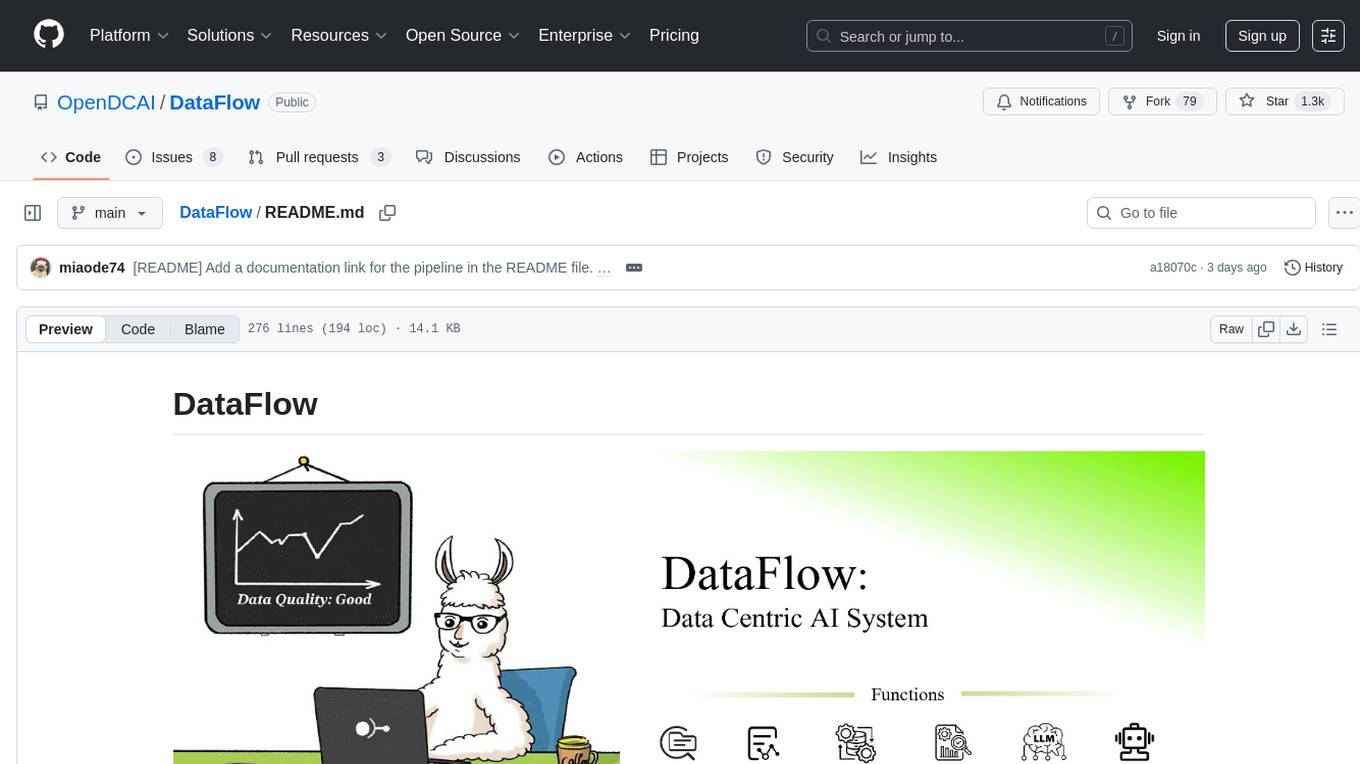
DataFlow
DataFlow is a data preparation and training system designed to parse, generate, process, and evaluate high-quality data from noisy sources, improving the performance of large language models in specific domains. It constructs diverse operators and pipelines, validated to enhance domain-oriented LLM's performance in fields like healthcare, finance, and law. DataFlow also features an intelligent DataFlow-agent capable of dynamically assembling new pipelines by recombining existing operators on demand.
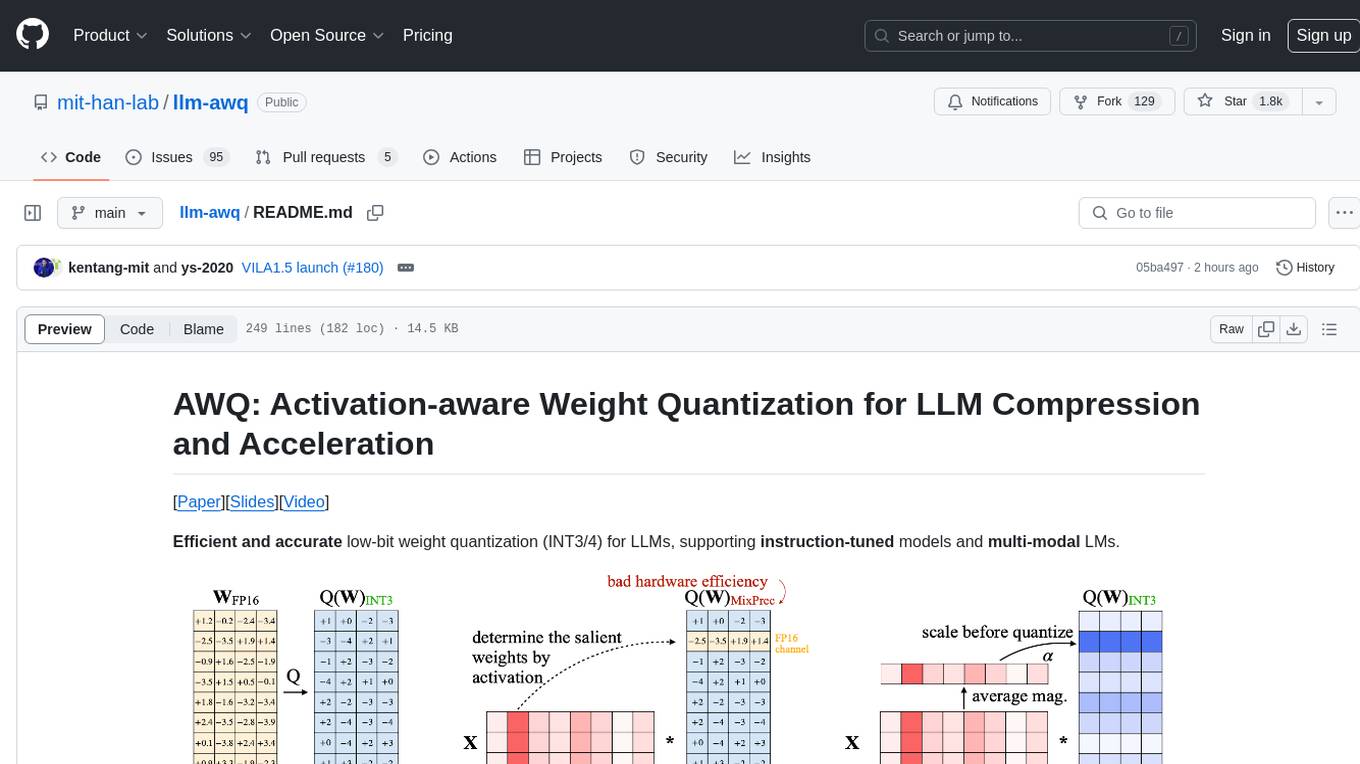
llm-awq
AWQ (Activation-aware Weight Quantization) is a tool designed for efficient and accurate low-bit weight quantization (INT3/4) for Large Language Models (LLMs). It supports instruction-tuned models and multi-modal LMs, providing features such as AWQ search for accurate quantization, pre-computed AWQ model zoo for various LLMs, memory-efficient 4-bit linear in PyTorch, and efficient CUDA kernel implementation for fast inference. The tool enables users to run large models on resource-constrained edge platforms, delivering more efficient responses with LLM/VLM chatbots through 4-bit inference.
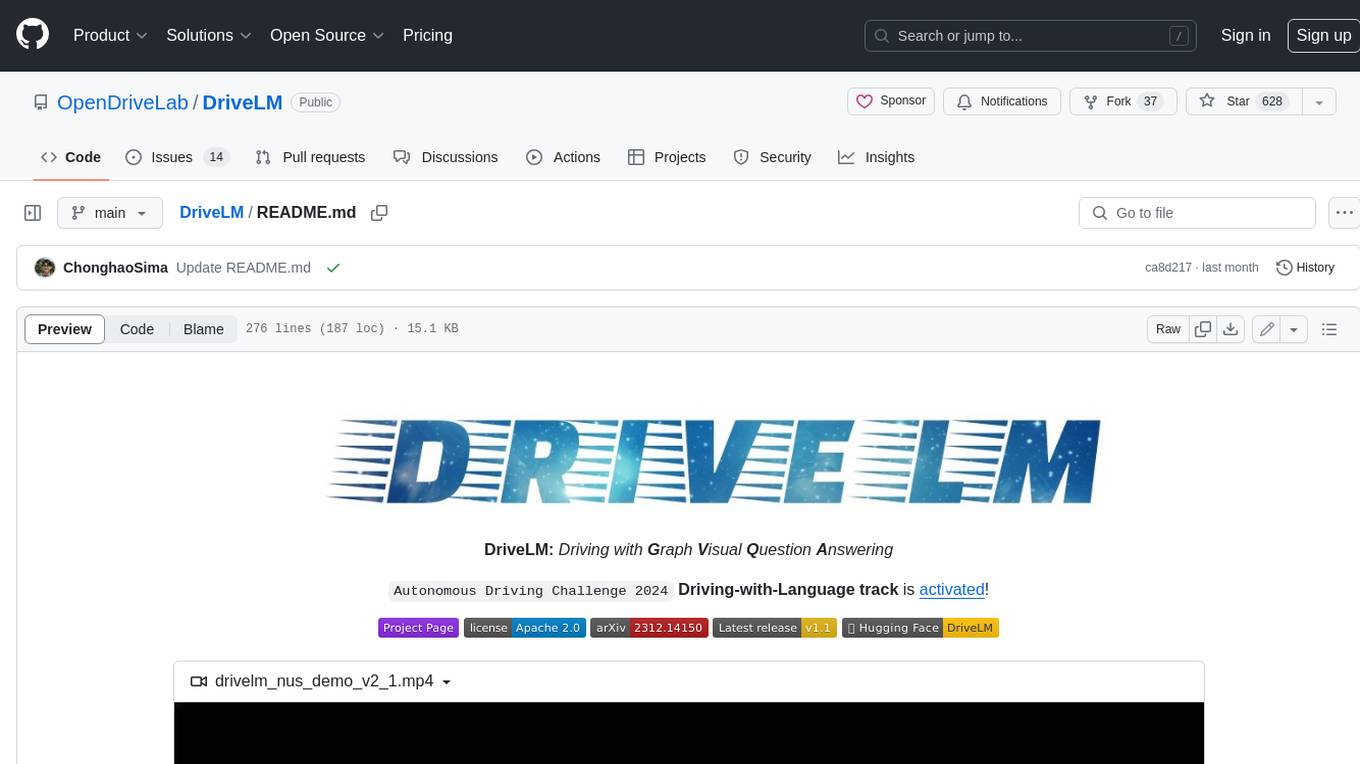
DriveLM
DriveLM is a multimodal AI model that enables autonomous driving by combining computer vision and natural language processing. It is designed to understand and respond to complex driving scenarios using visual and textual information. DriveLM can perform various tasks related to driving, such as object detection, lane keeping, and decision-making. It is trained on a massive dataset of images and text, which allows it to learn the relationships between visual cues and driving actions. DriveLM is a powerful tool that can help to improve the safety and efficiency of autonomous vehicles.
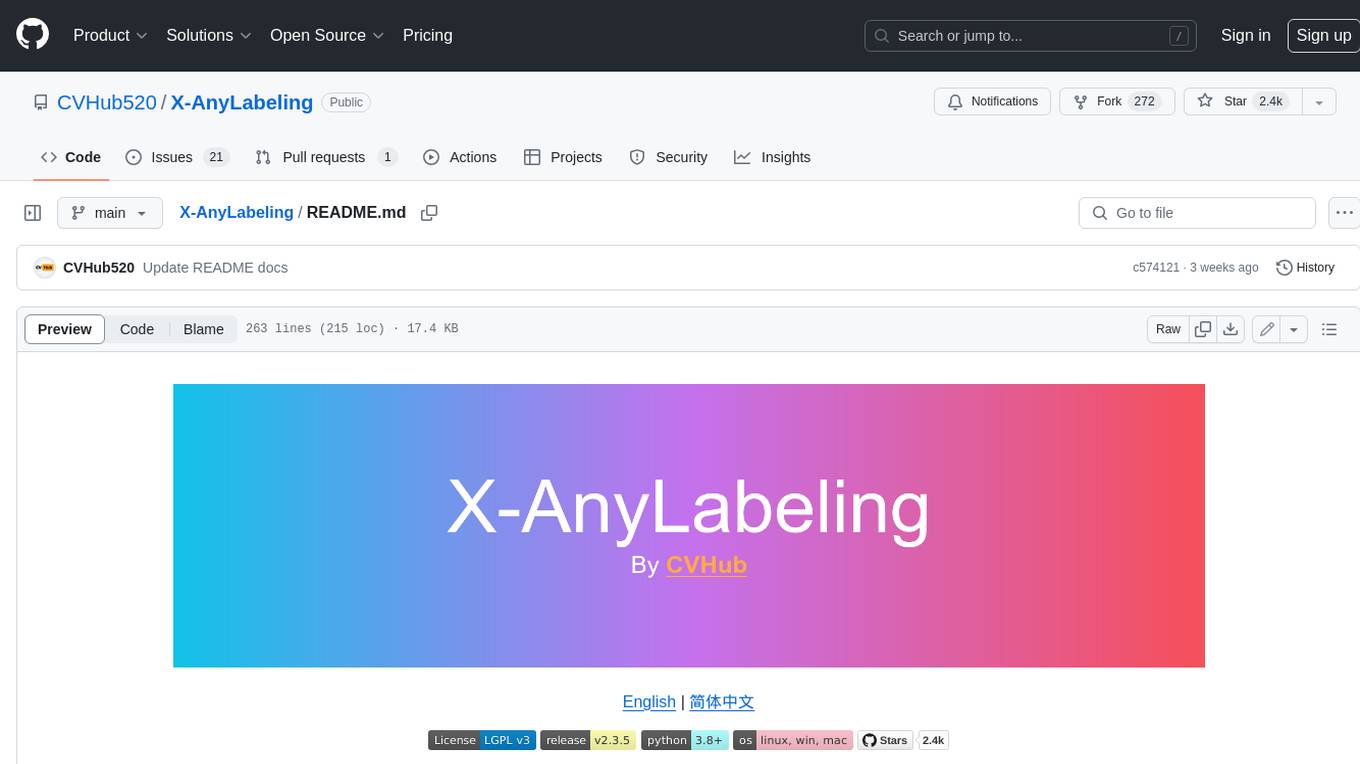
X-AnyLabeling
X-AnyLabeling is a robust annotation tool that seamlessly incorporates an AI inference engine alongside an array of sophisticated features. Tailored for practical applications, it is committed to delivering comprehensive, industrial-grade solutions for image data engineers. This tool excels in swiftly and automatically executing annotations across diverse and intricate tasks.
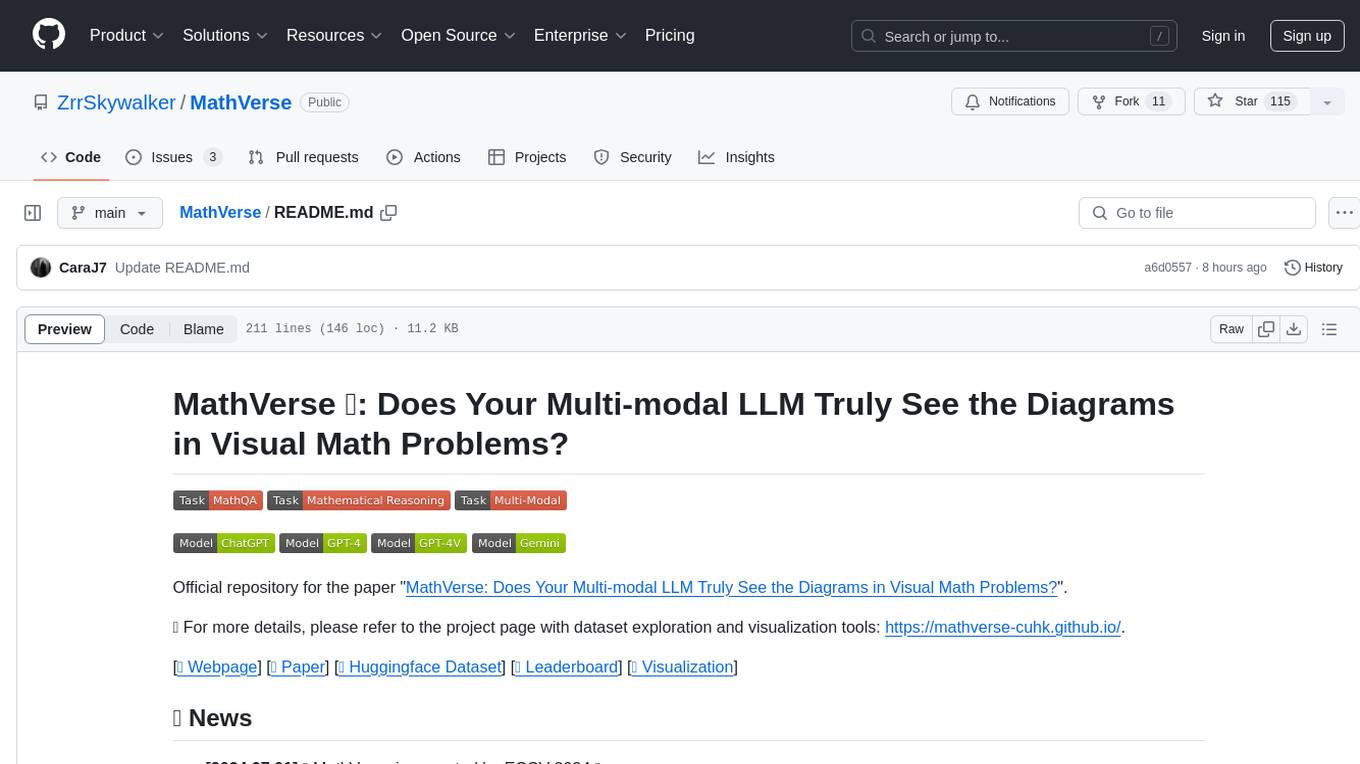
MathVerse
MathVerse is an all-around visual math benchmark designed to evaluate the capabilities of Multi-modal Large Language Models (MLLMs) in visual math problem-solving. It collects high-quality math problems with diagrams to assess how well MLLMs can understand visual diagrams for mathematical reasoning. The benchmark includes 2,612 problems transformed into six versions each, contributing to 15K test samples. It also introduces a Chain-of-Thought (CoT) Evaluation strategy for fine-grained assessment of output answers.
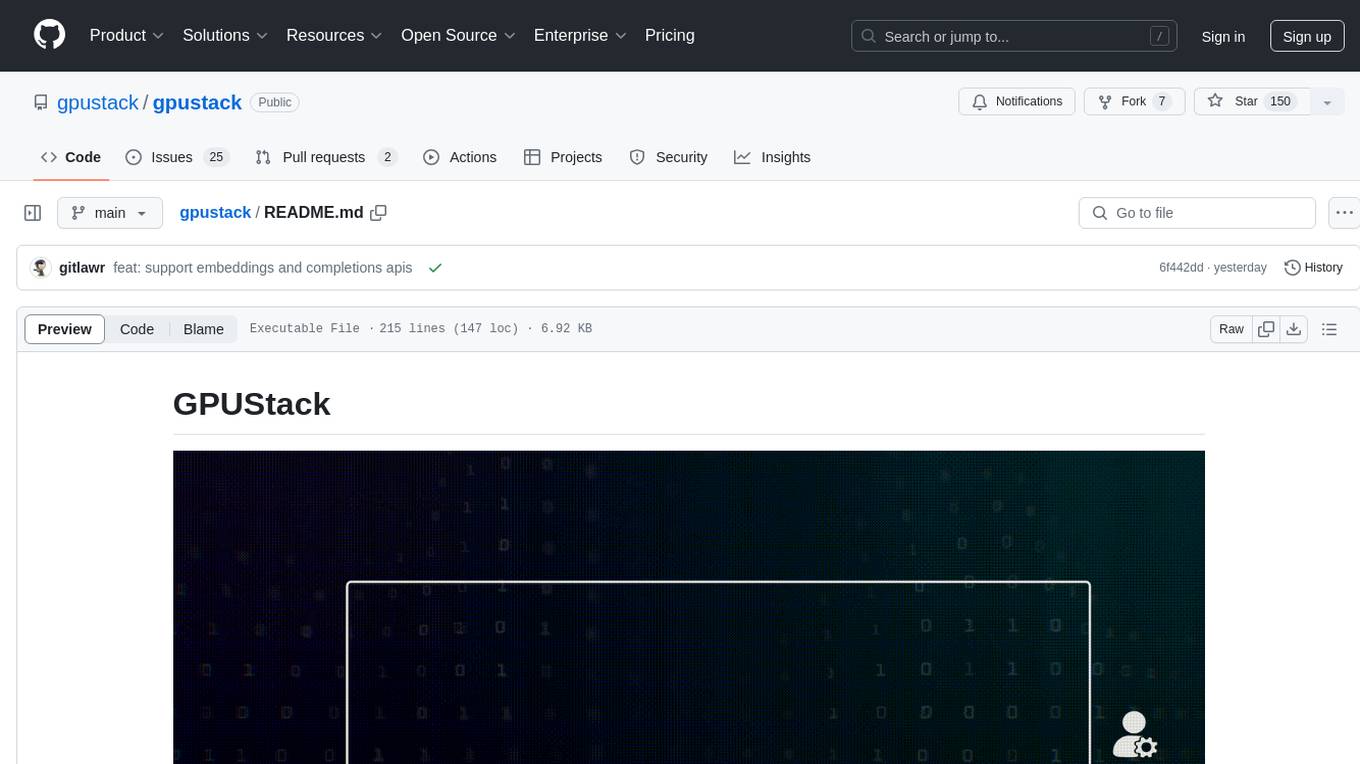
gpustack
GPUStack is an open-source GPU cluster manager designed for running large language models (LLMs). It supports a wide variety of hardware, scales with GPU inventory, offers lightweight Python package with minimal dependencies, provides OpenAI-compatible APIs, simplifies user and API key management, enables GPU metrics monitoring, and facilitates token usage and rate metrics tracking. The tool is suitable for managing GPU clusters efficiently and effectively.
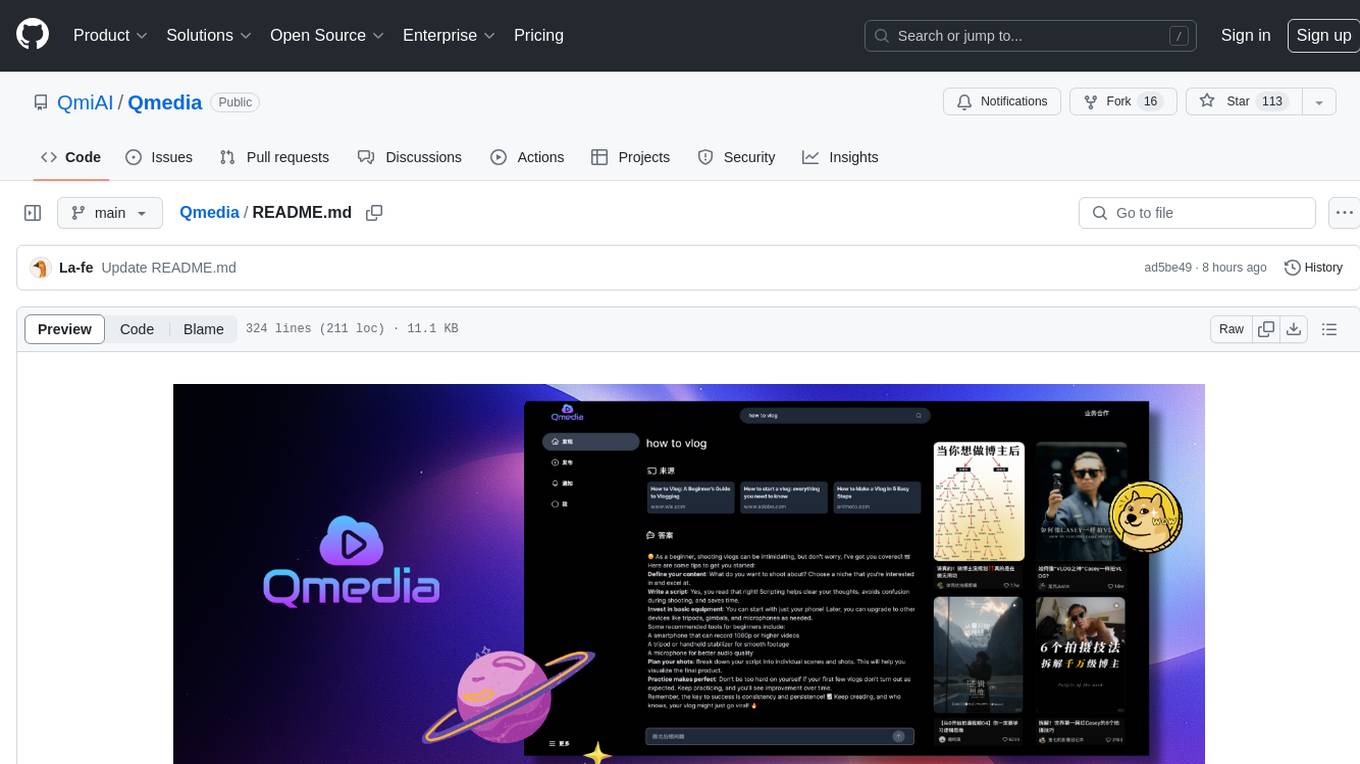
Qmedia
QMedia is an open-source multimedia AI content search engine designed specifically for content creators. It provides rich information extraction methods for text, image, and short video content. The tool integrates unstructured text, image, and short video information to build a multimodal RAG content Q&A system. Users can efficiently search for image/text and short video materials, analyze content, provide content sources, and generate customized search results based on user interests and needs. QMedia supports local deployment for offline content search and Q&A for private data. The tool offers features like content cards display, multimodal content RAG search, and pure local multimodal models deployment. Users can deploy different types of models locally, manage language models, feature embedding models, image models, and video models. QMedia aims to spark new ideas for content creation and share AI content creation concepts in an open-source manner.
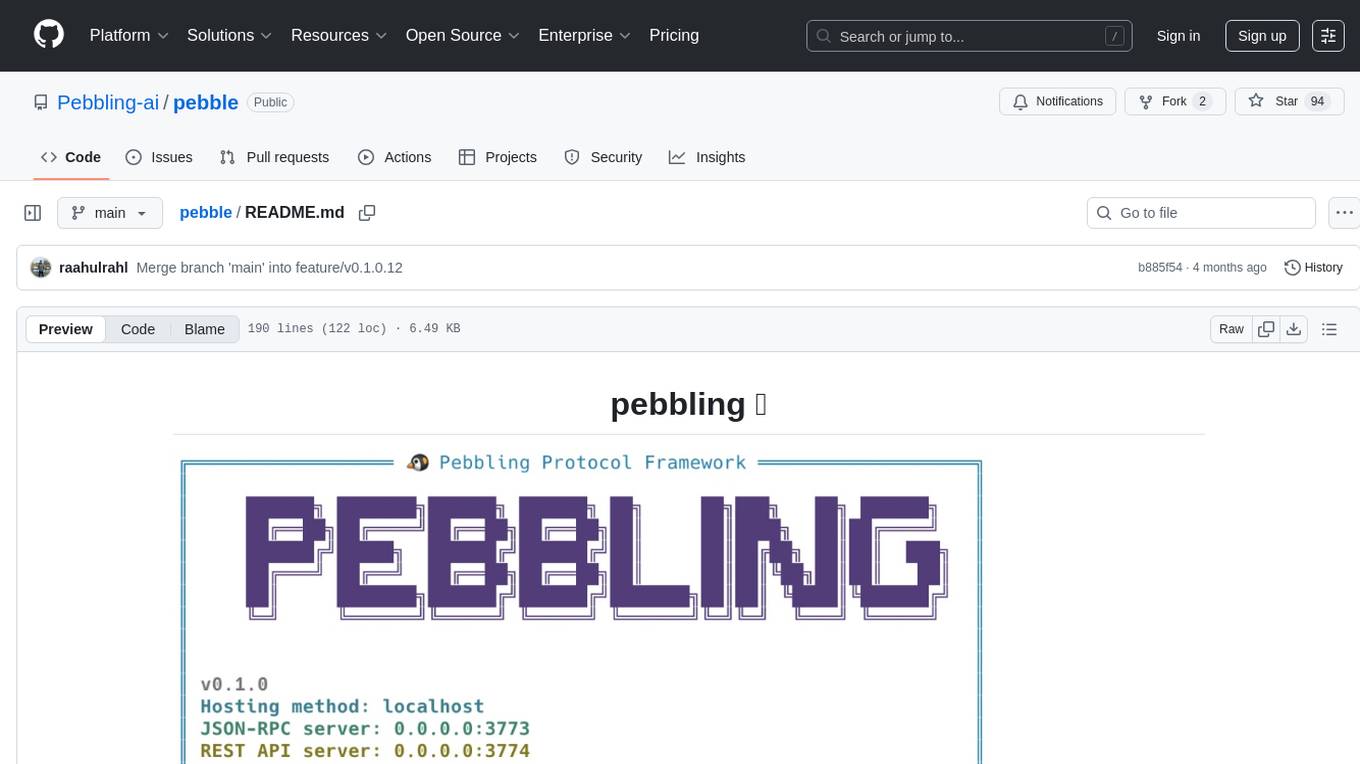
pebble
Pebbling is an open-source protocol for agent-to-agent communication, enabling AI agents to collaborate securely using Decentralised Identifiers (DIDs) and mutual TLS (mTLS). It provides a lightweight communication protocol built on JSON-RPC 2.0, ensuring reliable and secure conversations between agents. Pebbling allows agents to exchange messages safely, connect seamlessly regardless of programming language, and communicate quickly and efficiently. It is designed to pave the way for the next generation of collaborative AI systems, promoting secure and effortless communication between agents across different environments.
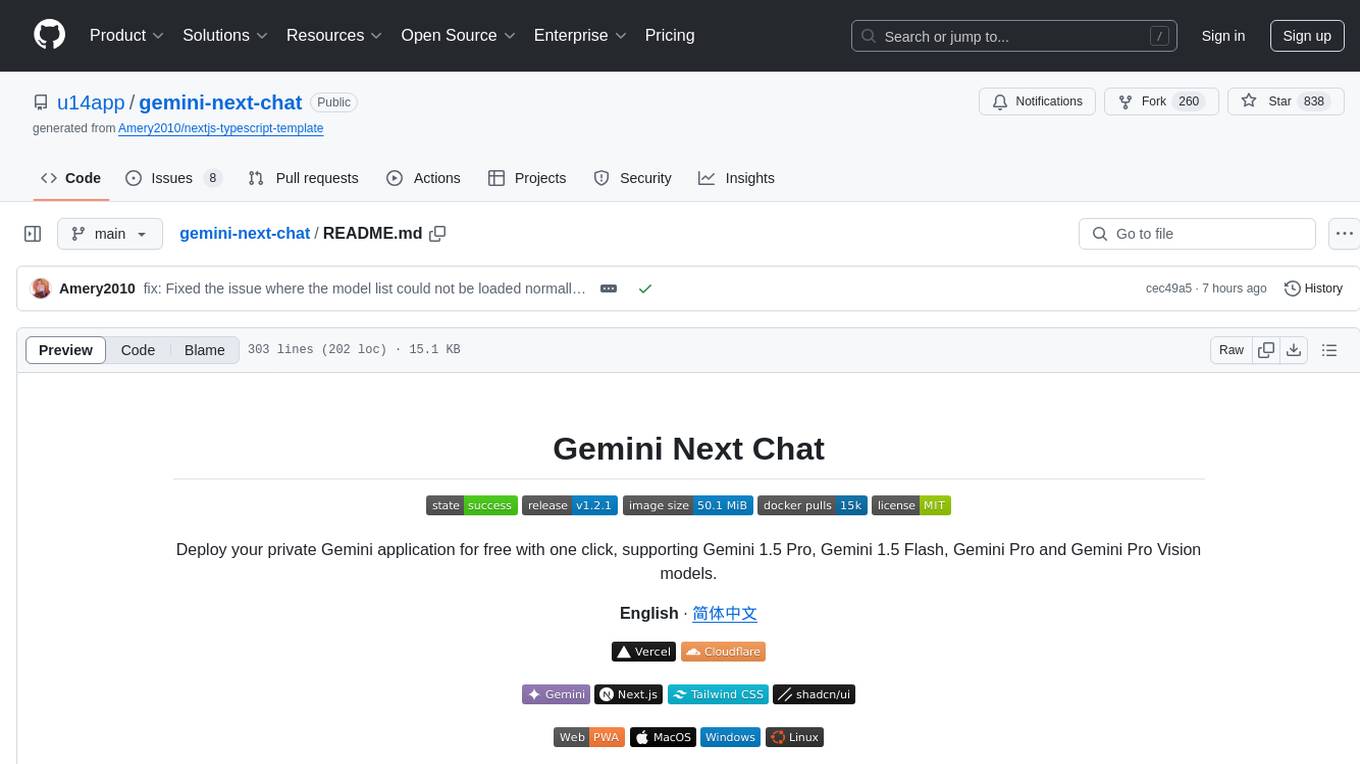
gemini-next-chat
Gemini Next Chat is an open-source, extensible high-performance Gemini chatbot framework that supports one-click free deployment of private Gemini web applications. It provides a simple interface with image recognition and voice conversation, supports multi-modal models, talk mode, visual recognition, assistant market, support plugins, conversation list, full Markdown support, privacy and security, PWA support, well-designed UI, fast loading speed, static deployment, and multi-language support.
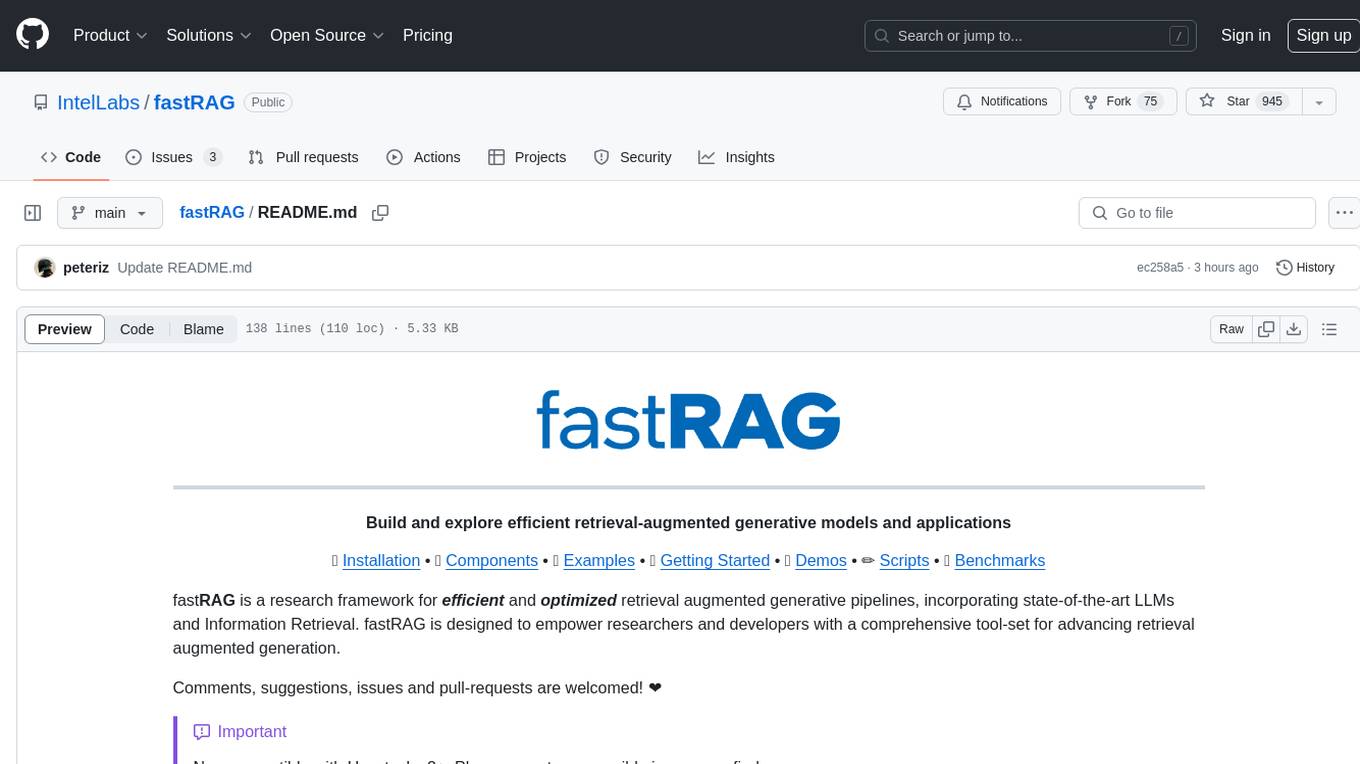
fastRAG
fastRAG is a research framework designed to build and explore efficient retrieval-augmented generative models. It incorporates state-of-the-art Large Language Models (LLMs) and Information Retrieval to empower researchers and developers with a comprehensive tool-set for advancing retrieval augmented generation. The framework is optimized for Intel hardware, customizable, and includes key features such as optimized RAG pipelines, efficient components, and RAG-efficient components like ColBERT and Fusion-in-Decoder (FiD). fastRAG supports various unique components and backends for running LLMs, making it a versatile tool for research and development in the field of retrieval-augmented generation.
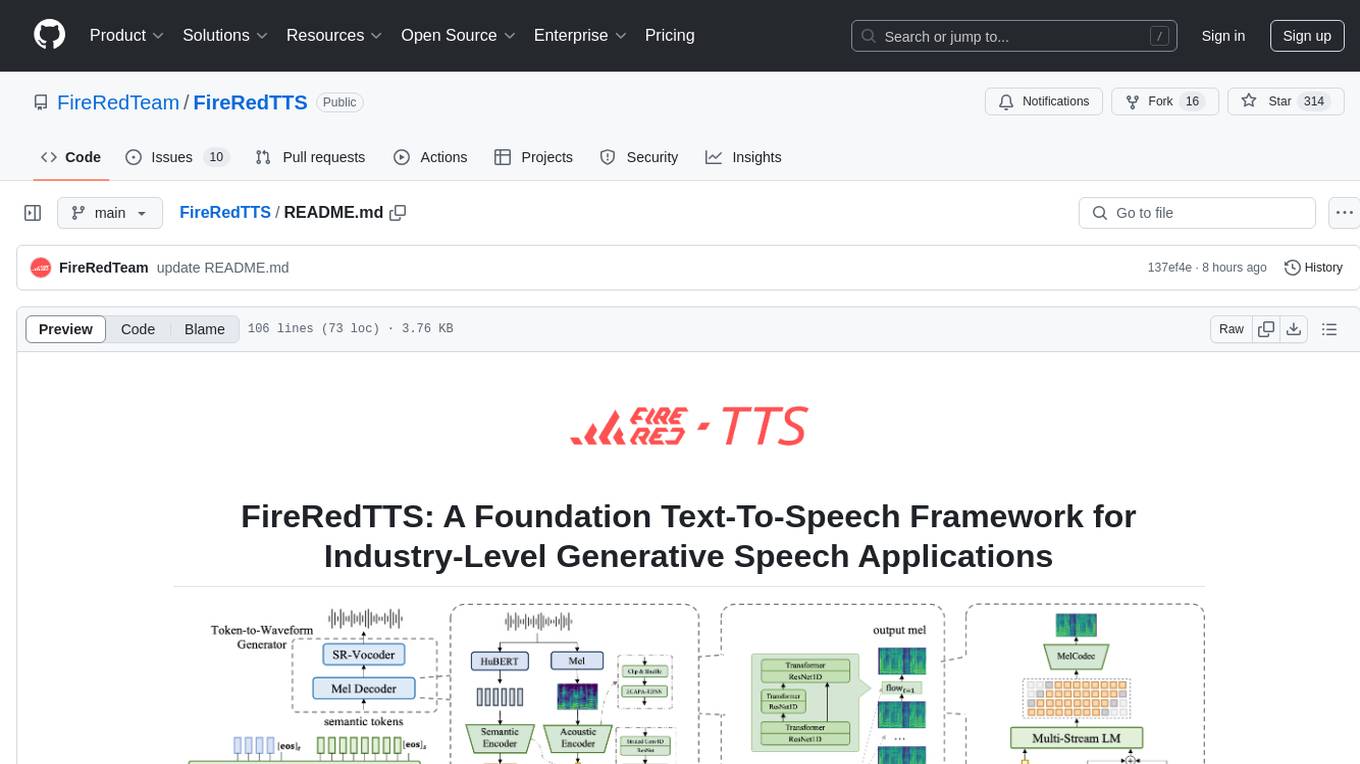
FireRedTTS
FireRedTTS is a foundation text-to-speech framework designed for industry-level generative speech applications. It offers a rich-punctuation model with expanded punctuation coverage and enhanced audio production consistency. The tool provides pre-trained checkpoints, inference code, and an interactive demo space. Users can clone the repository, create a conda environment, download required model files, and utilize the tool for synthesizing speech in various languages. FireRedTTS aims to enhance stability and provide controllable human-like speech generation capabilities.

agentic-radar
The Agentic Radar is a security scanner designed to analyze and assess agentic systems for security and operational insights. It helps users understand how agentic systems function, identify potential vulnerabilities, and create security reports. The tool includes workflow visualization, tool identification, and vulnerability mapping, providing a comprehensive HTML report for easy reviewing and sharing. It simplifies the process of assessing complex workflows and multiple tools used in agentic systems, offering a structured view of potential risks and security frameworks.
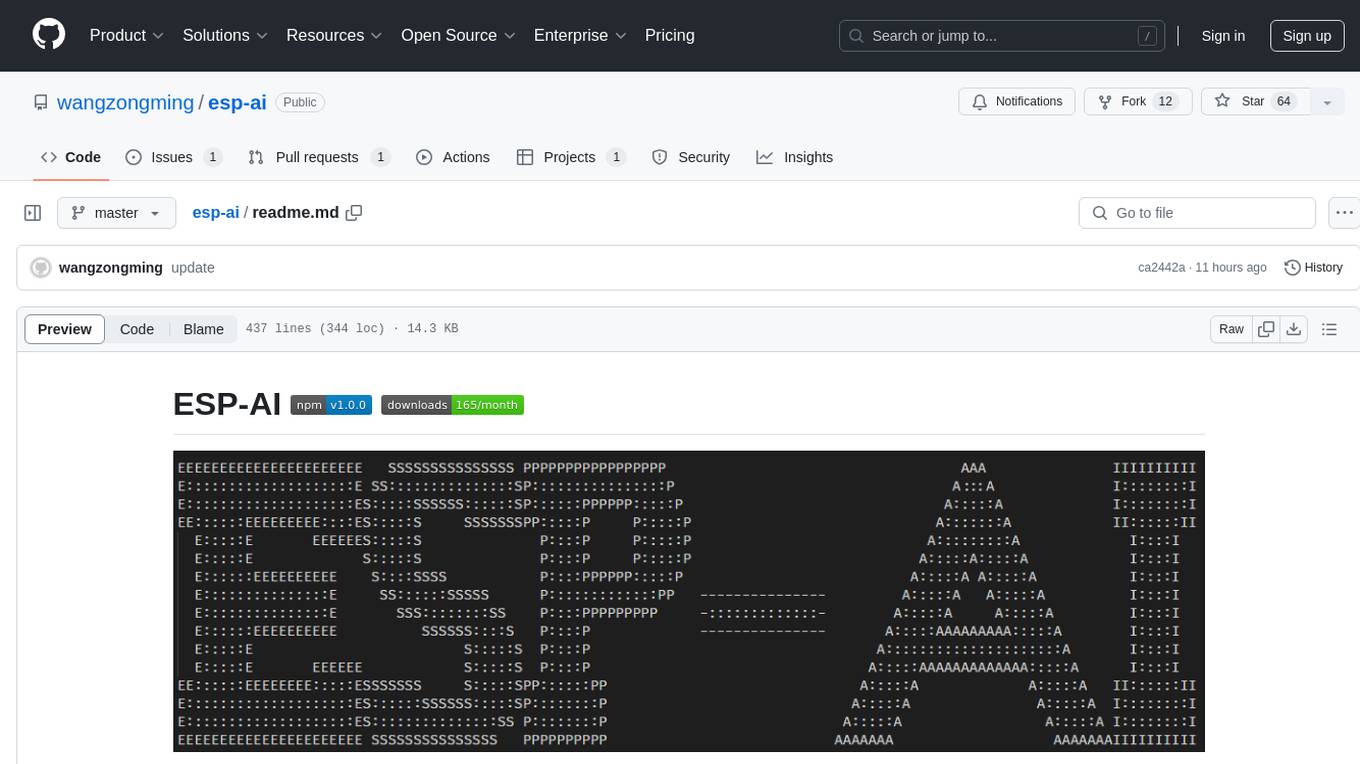
esp-ai
ESP-AI provides a complete AI conversation solution for your development board, including IAT+LLM+TTS integration solutions for ESP32 series development boards. It can be injected into projects without affecting existing ones. By providing keys from platforms like iFlytek, Jiling, and local services, you can run the services without worrying about interactions between services or between development boards and services. The project's server-side code is based on Node.js, and the hardware code is based on Arduino IDE.
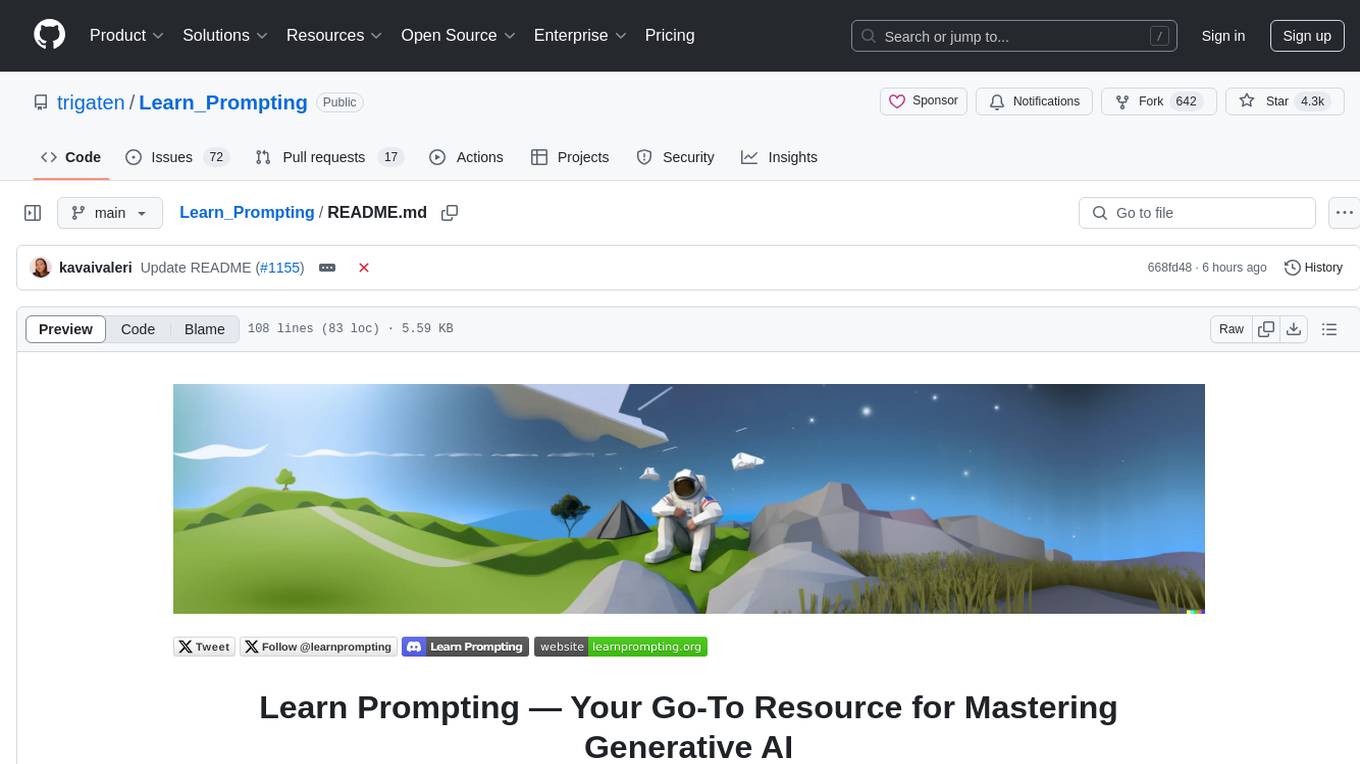
Learn_Prompting
Learn Prompting is a platform offering free resources, courses, and webinars to master prompt engineering and generative AI. It provides a Prompt Engineering Guide, courses on Generative AI, workshops, and the HackAPrompt competition. The platform also offers AI Red Teaming and AI Safety courses, research reports on prompting techniques, and welcomes contributions in various forms such as content suggestions, translations, artwork, and typo fixes. Users can locally develop the website using Visual Studio Code, Git, and Node.js, and run it in development mode to preview changes.
For similar tasks

NExT-GPT
NExT-GPT is an end-to-end multimodal large language model that can process input and generate output in various combinations of text, image, video, and audio. It leverages existing pre-trained models and diffusion models with end-to-end instruction tuning. The repository contains code, data, and model weights for NExT-GPT, allowing users to work with different modalities and perform tasks like encoding, understanding, reasoning, and generating multimodal content.
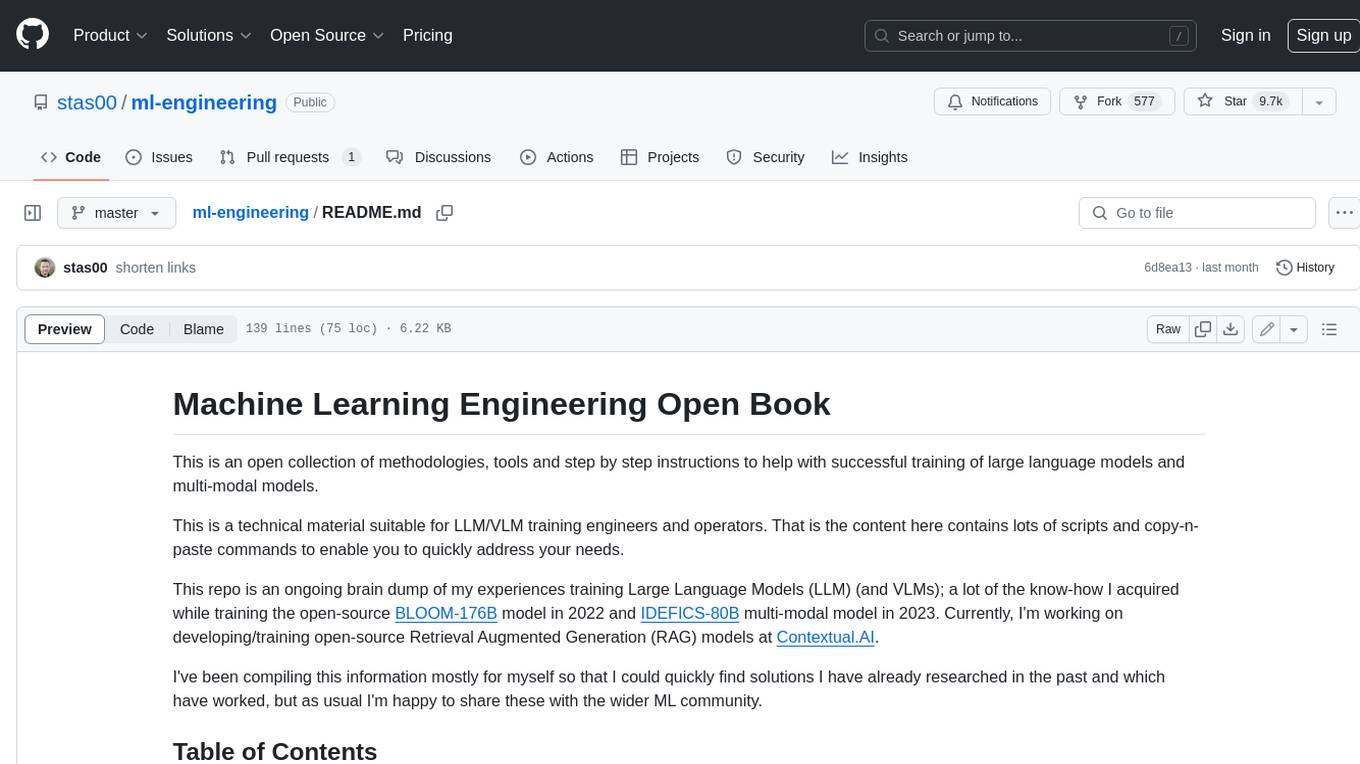
ml-engineering
This repository provides a comprehensive collection of methodologies, tools, and step-by-step instructions for successful training of large language models (LLMs) and multi-modal models. It is a technical resource suitable for LLM/VLM training engineers and operators, containing numerous scripts and copy-n-paste commands to facilitate quick problem-solving. The repository is an ongoing compilation of the author's experiences training BLOOM-176B and IDEFICS-80B models, and currently focuses on the development and training of Retrieval Augmented Generation (RAG) models at Contextual.AI. The content is organized into six parts: Insights, Hardware, Orchestration, Training, Development, and Miscellaneous. It includes key comparison tables for high-end accelerators and networks, as well as shortcuts to frequently needed tools and guides. The repository is open to contributions and discussions, and is licensed under Attribution-ShareAlike 4.0 International.
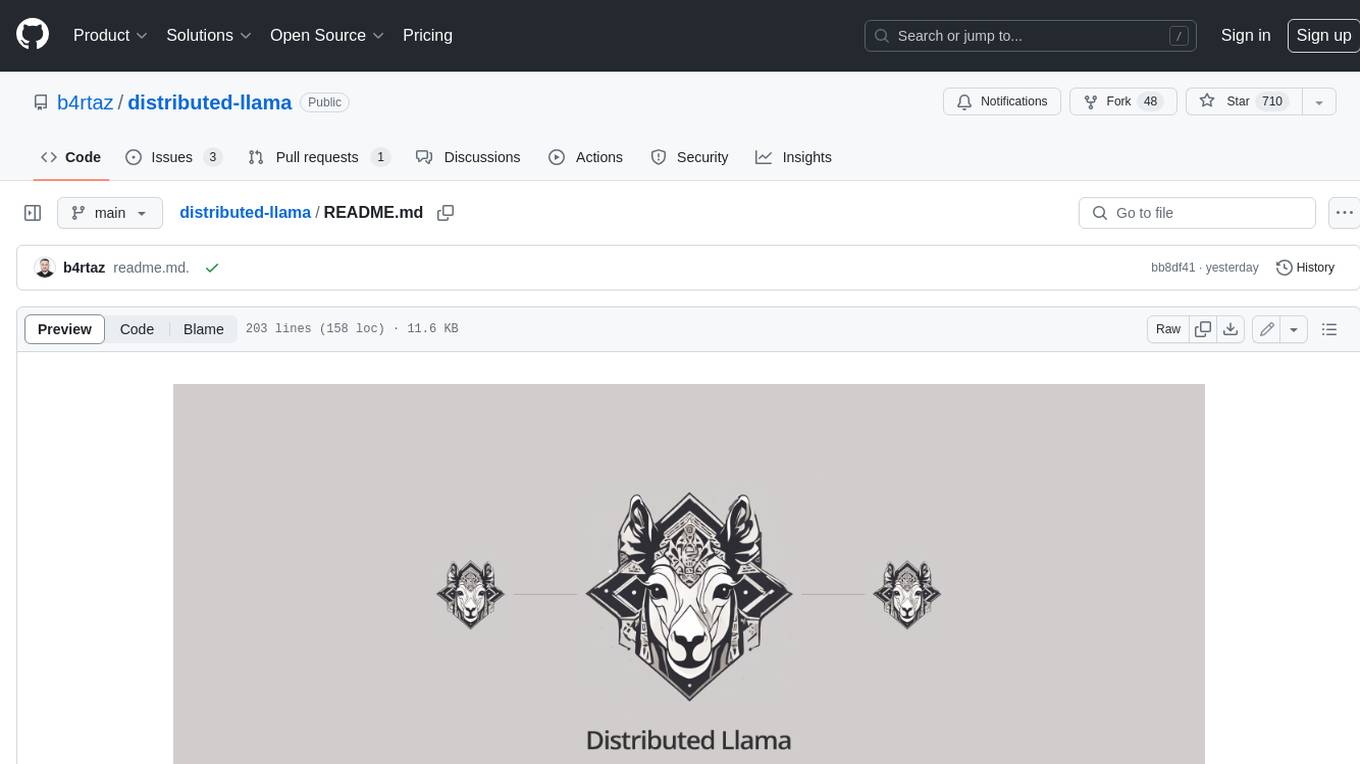
distributed-llama
Distributed Llama is a tool that allows you to run large language models (LLMs) on weak devices or make powerful devices even more powerful by distributing the workload and dividing the RAM usage. It uses TCP sockets to synchronize the state of the neural network, and you can easily configure your AI cluster by using a home router. Distributed Llama supports models such as Llama 2 (7B, 13B, 70B) chat and non-chat versions, Llama 3, and Grok-1 (314B).
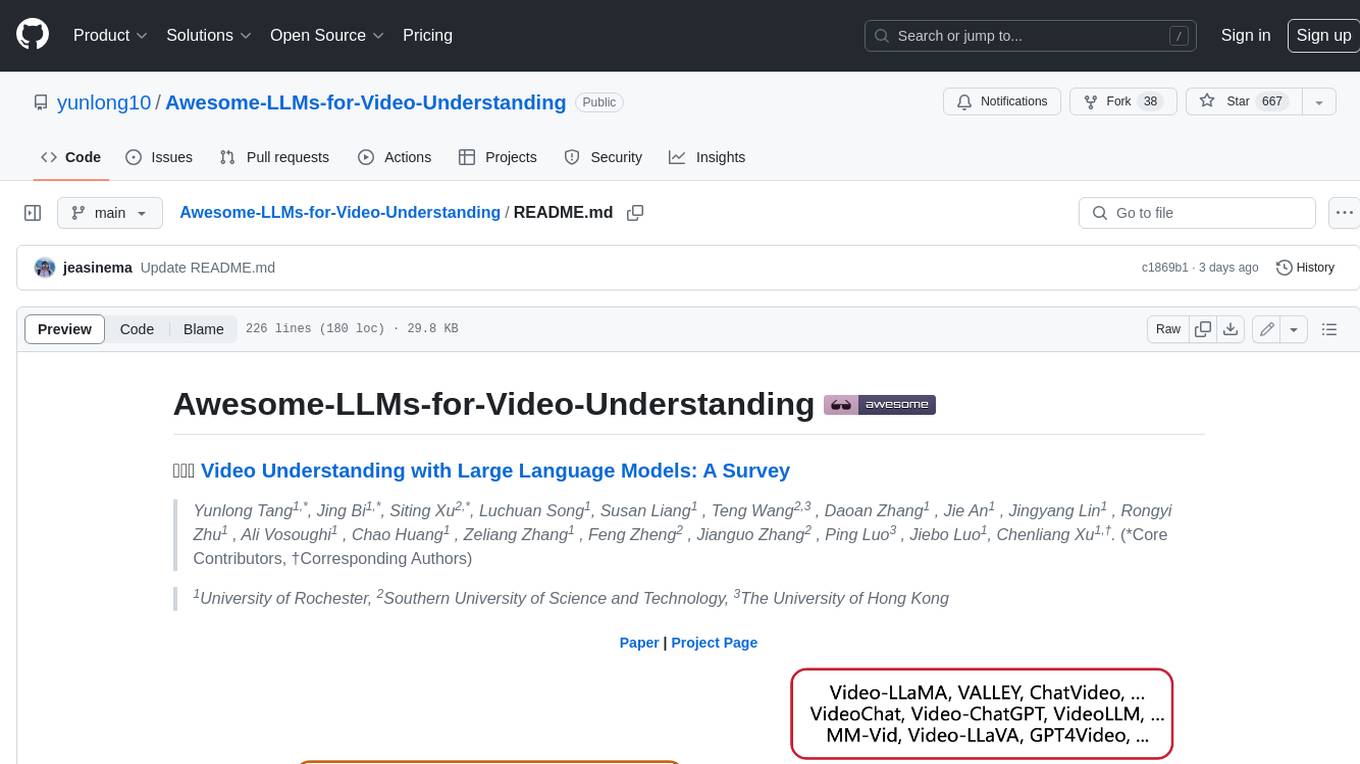
Awesome-LLMs-for-Video-Understanding
Awesome-LLMs-for-Video-Understanding is a repository dedicated to exploring Video Understanding with Large Language Models. It provides a comprehensive survey of the field, covering models, pretraining, instruction tuning, and hybrid methods. The repository also includes information on tasks, datasets, and benchmarks related to video understanding. Contributors are encouraged to add new papers, projects, and materials to enhance the repository.
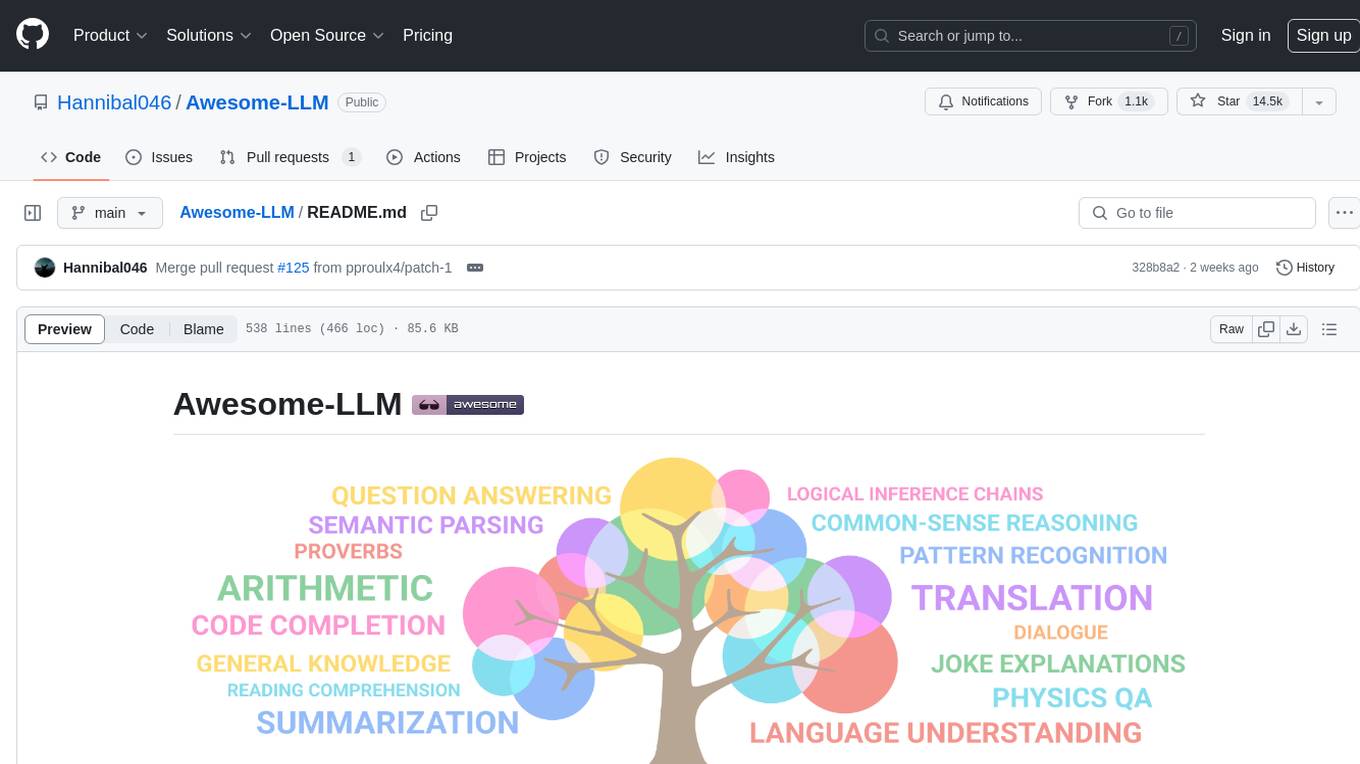
Awesome-LLM
Awesome-LLM is a curated list of resources related to large language models, focusing on papers, projects, frameworks, tools, tutorials, courses, opinions, and other useful resources in the field. It covers trending LLM projects, milestone papers, other papers, open LLM projects, LLM training frameworks, LLM evaluation frameworks, tools for deploying LLM, prompting libraries & tools, tutorials, courses, books, and opinions. The repository provides a comprehensive overview of the latest advancements and resources in the field of large language models.
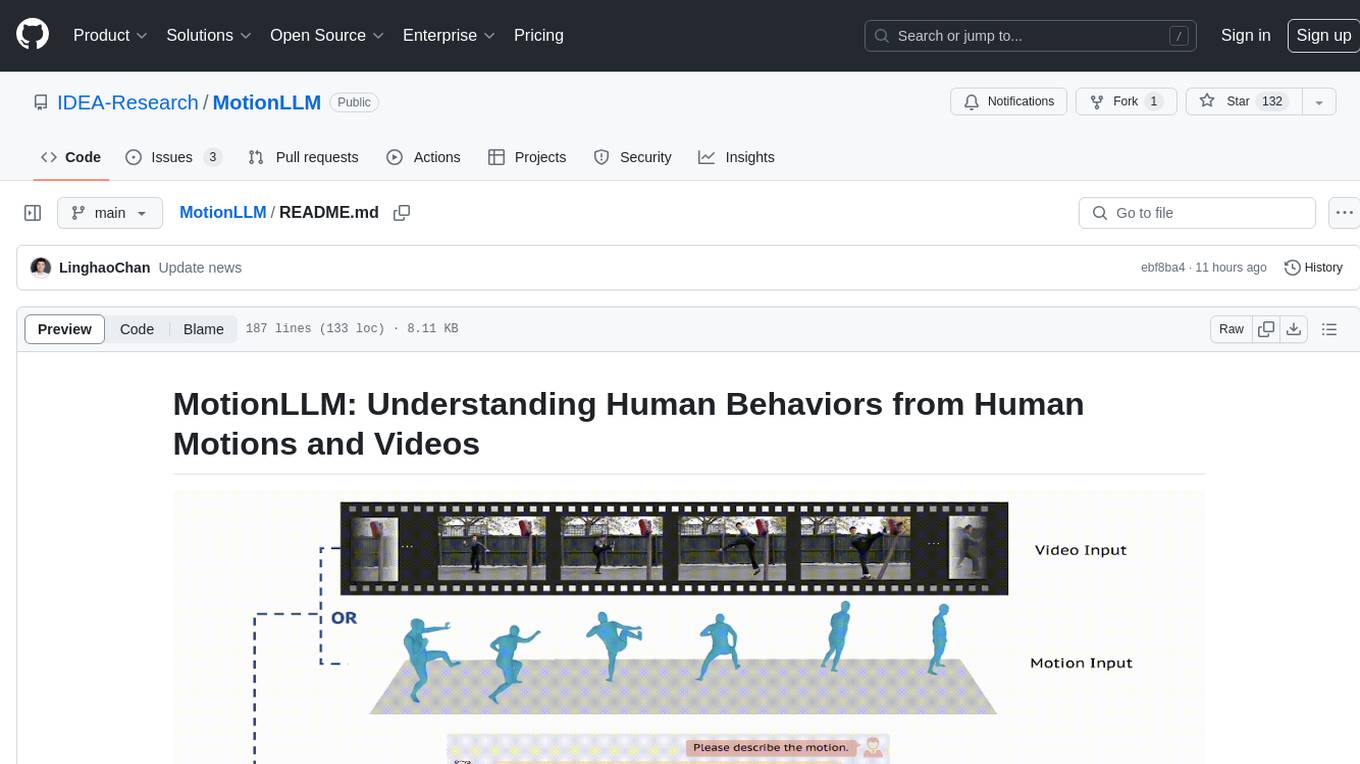
MotionLLM
MotionLLM is a framework for human behavior understanding that leverages Large Language Models (LLMs) to jointly model videos and motion sequences. It provides a unified training strategy, dataset MoVid, and MoVid-Bench for evaluating human behavior comprehension. The framework excels in captioning, spatial-temporal comprehension, and reasoning abilities.
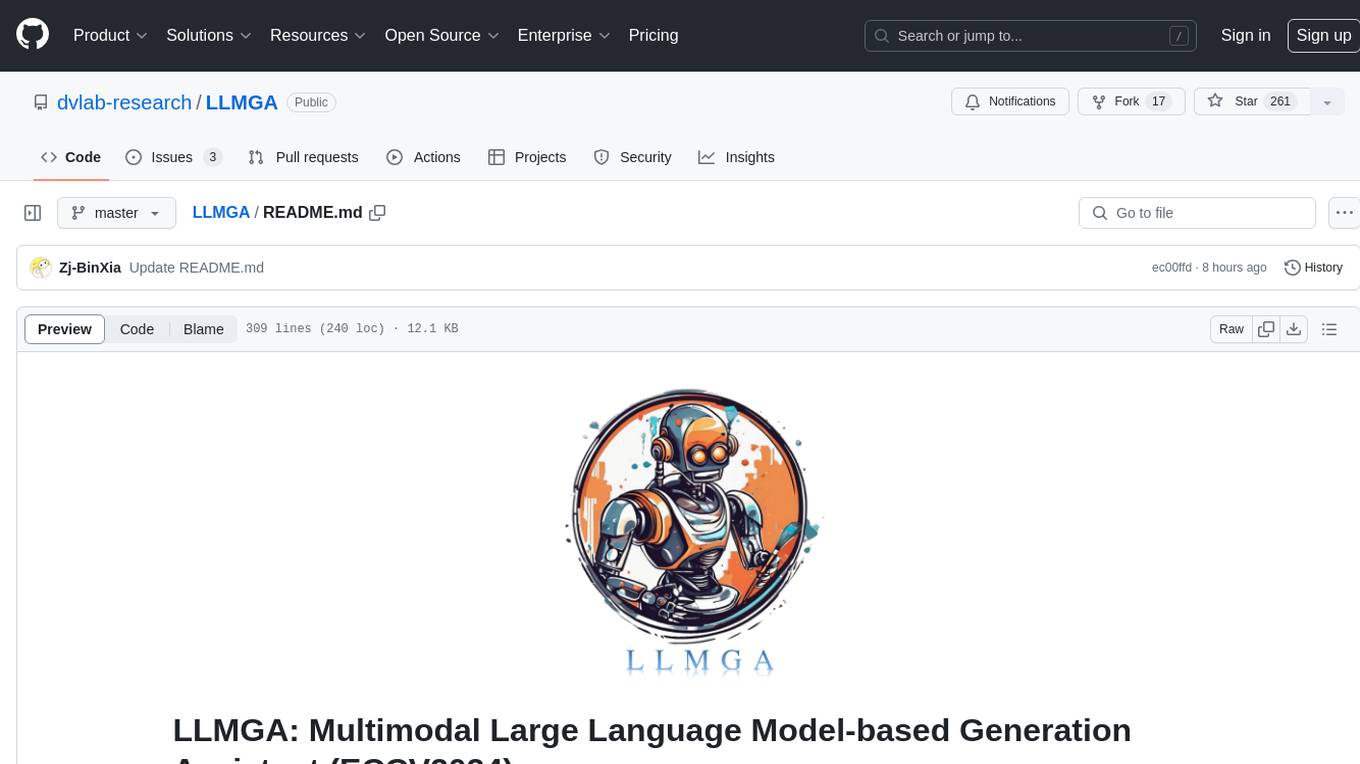
LLMGA
LLMGA (Multimodal Large Language Model-based Generation Assistant) is a tool that leverages Large Language Models (LLMs) to assist users in image generation and editing. It provides detailed language generation prompts for precise control over Stable Diffusion (SD), resulting in more intricate and precise content in generated images. The tool curates a dataset for prompt refinement, similar image generation, inpainting & outpainting, and visual question answering. It offers a two-stage training scheme to optimize SD alignment and a reference-based restoration network to alleviate texture, brightness, and contrast disparities in image editing. LLMGA shows promising generative capabilities and enables wider applications in an interactive manner.
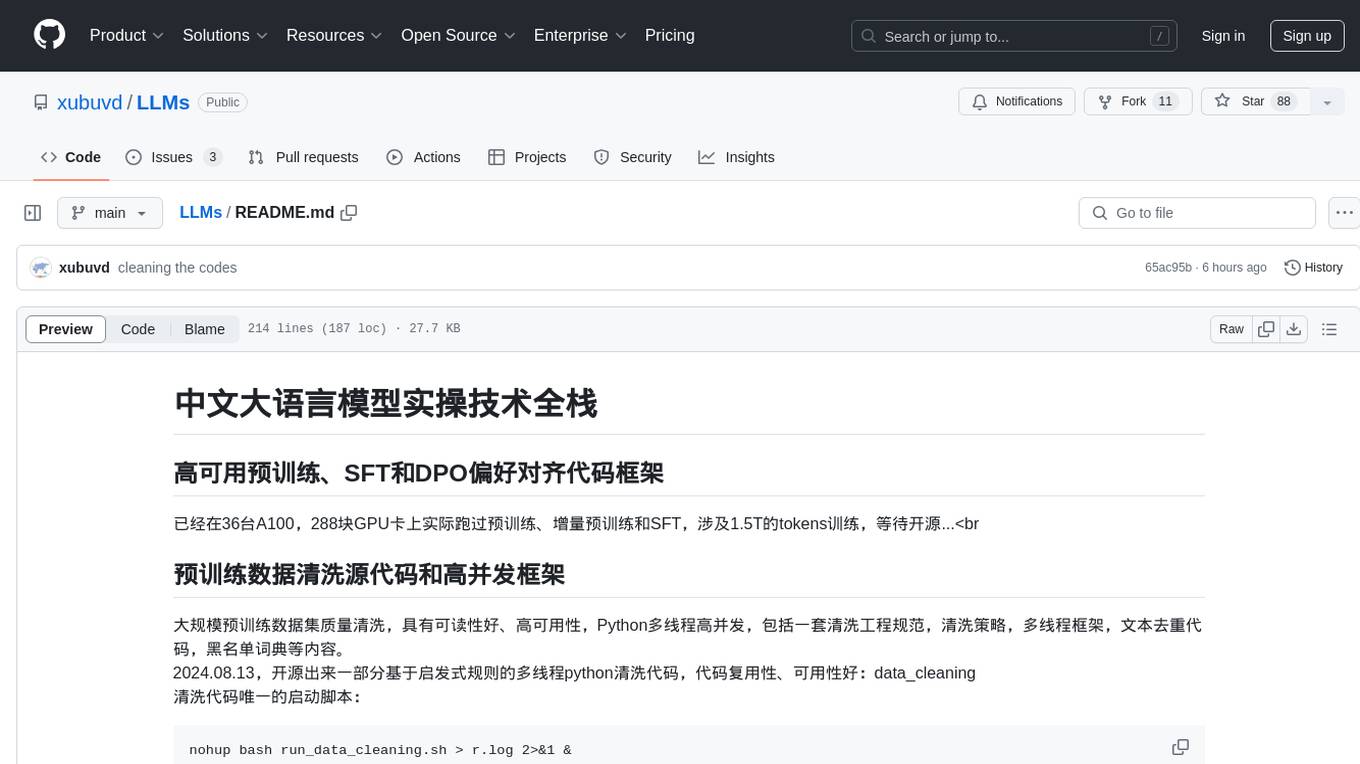
LLMs
LLMs is a Chinese large language model technology stack for practical use. It includes high-availability pre-training, SFT, and DPO preference alignment code framework. The repository covers pre-training data cleaning, high-concurrency framework, SFT dataset cleaning, data quality improvement, and security alignment work for Chinese large language models. It also provides open-source SFT dataset construction, pre-training from scratch, and various tools and frameworks for data cleaning, quality optimization, and task alignment.
For similar jobs

weave
Weave is a toolkit for developing Generative AI applications, built by Weights & Biases. With Weave, you can log and debug language model inputs, outputs, and traces; build rigorous, apples-to-apples evaluations for language model use cases; and organize all the information generated across the LLM workflow, from experimentation to evaluations to production. Weave aims to bring rigor, best-practices, and composability to the inherently experimental process of developing Generative AI software, without introducing cognitive overhead.

LLMStack
LLMStack is a no-code platform for building generative AI agents, workflows, and chatbots. It allows users to connect their own data, internal tools, and GPT-powered models without any coding experience. LLMStack can be deployed to the cloud or on-premise and can be accessed via HTTP API or triggered from Slack or Discord.

VisionCraft
The VisionCraft API is a free API for using over 100 different AI models. From images to sound.

kaito
Kaito is an operator that automates the AI/ML inference model deployment in a Kubernetes cluster. It manages large model files using container images, avoids tuning deployment parameters to fit GPU hardware by providing preset configurations, auto-provisions GPU nodes based on model requirements, and hosts large model images in the public Microsoft Container Registry (MCR) if the license allows. Using Kaito, the workflow of onboarding large AI inference models in Kubernetes is largely simplified.

PyRIT
PyRIT is an open access automation framework designed to empower security professionals and ML engineers to red team foundation models and their applications. It automates AI Red Teaming tasks to allow operators to focus on more complicated and time-consuming tasks and can also identify security harms such as misuse (e.g., malware generation, jailbreaking), and privacy harms (e.g., identity theft). The goal is to allow researchers to have a baseline of how well their model and entire inference pipeline is doing against different harm categories and to be able to compare that baseline to future iterations of their model. This allows them to have empirical data on how well their model is doing today, and detect any degradation of performance based on future improvements.

tabby
Tabby is a self-hosted AI coding assistant, offering an open-source and on-premises alternative to GitHub Copilot. It boasts several key features: * Self-contained, with no need for a DBMS or cloud service. * OpenAPI interface, easy to integrate with existing infrastructure (e.g Cloud IDE). * Supports consumer-grade GPUs.

spear
SPEAR (Simulator for Photorealistic Embodied AI Research) is a powerful tool for training embodied agents. It features 300 unique virtual indoor environments with 2,566 unique rooms and 17,234 unique objects that can be manipulated individually. Each environment is designed by a professional artist and features detailed geometry, photorealistic materials, and a unique floor plan and object layout. SPEAR is implemented as Unreal Engine assets and provides an OpenAI Gym interface for interacting with the environments via Python.

Magick
Magick is a groundbreaking visual AIDE (Artificial Intelligence Development Environment) for no-code data pipelines and multimodal agents. Magick can connect to other services and comes with nodes and templates well-suited for intelligent agents, chatbots, complex reasoning systems and realistic characters.





